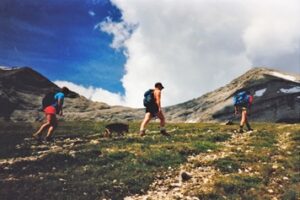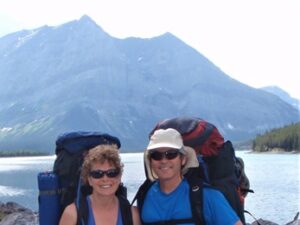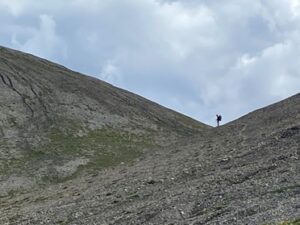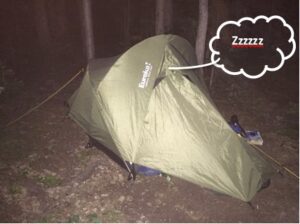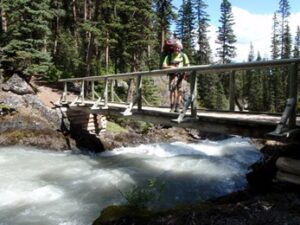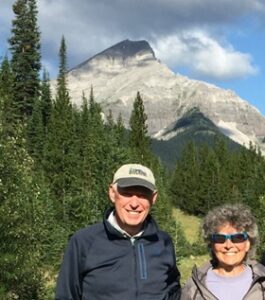By Jenny Feick, PhD
All pictures are by the author unless otherwise credited and along the GDT unless stated otherwise.
“Above all, do not lose your desire to walk. Every day I walk myself into a state of well-being and walk away from every illness. I have walked myself into my best thoughts, and I know of no thought so burdensome that one cannot walk away from it.” – Soren Kierkegaard
Since we were in high school together in the early 1970s in Kitchener, Ontario, Dave Higgins and I were aware of some of the health benefits of doing physical exercise outdoors in nature. Fortunately, we had an excellent “outdoor pursuits” component to our physical and health education courses at Cameron Heights Collegiate Institute with knowledgeable, skilled and inspirational teachers. The CHCI Outdoors Club that Dave led got us out hiking not just on local trails but also on the Bruce Trail along the Niagara Escarpment, our first exposure to the long-distance trail phenomenon. Dave and I became the youngest people to serve on the Board of Directors of the new Grand Valley Trail Association, which established a long-distance trail along the Grand River. Through these trail organizations, we met fit, healthy older folks who kindly took us out cross-country skiing and hiking, instilling in us a love of physical exercise in the great outdoors. This led to our interest in participating in the trails surveys in 1974 to find a route for the Great Divide Trail between Banff and Waterton Lakes national parks.

The initial gains we experienced related to general physical fitness, particularly cardiovascular health, strength, and endurance. However, what we didn’t fully appreciate until years later were the benefits to our immune systems, our cognitive wellbeing, and even our spiritual health. Multiplied across the country, the benefits of being physically active outdoors in nature has led to positive societal repercussions for the health care system and the economy. On another level, people who experience wild places often, like us, become advocates for the protection and care of these areas. When governments conserve these wild places, clean air, clean water and natural biodiversity persists. Then the many ecosystem services these areas provide will endure, including those that ameliorate global climate disruption.
While we have individual personal experience relevant to this topic, it’s anecdotal. Scientists have been studying the health benefits of outdoor physical exercise, including long-distance walking in natural surroundings, for decades. Examining some of the articles and books about their research yields the following six physical benefits and seven mental and emotional benefits of long-distance hiking in natural areas, such as Canada’s Great Divide Trail.
Physical Benefits
1. Hiking Helps Heart Health
The most obvious benefit of long-distance hiking is its effect on your cardiovascular health. Hiking elevates one’s heart rate, which helps improve aerobic fitness and endurance. It strengthens your heart muscles. As with any physical activity, when you hike, your heart must work harder to pump blood and oxygen throughout your body and into all your muscles. Over time, this improves heart function. So, as you hike day after day, your body adjusts to new fitness levels and you will be able to hike longer distances, at a faster rate, over more challenging terrain, without feeling as breathless or fatigued.
Studies demonstrate that going on regular moderate hikes over time significantly reduces hypertension, improves glucose tolerance, and decreases ‘bad’ cholesterol levels. Studies in Japan have also shown that walking in forests, especially coniferous forests, lowers both blood pressure and heart rate. Thus, long distance hiking can also improve cardiovascular health markers such as blood pressure, blood sugar levels, and cholesterol.
2. Hike to Live Long and Live Well
Research shows that not only does hiking at a brisk pace for at least 30 minutes each day help to drastically reduce one’s chances of developing heart disease, it also lowers the risk of contracting some cancers and developing dementia in older age. Besides improving short term health, hiking also helps build a foundation of health as we age. Sunlight kick starts the body’s production of Vitamin D, which alleviates stress, and gives some disease protection. While not a guarantee, hiking increases the likelihood that you will live a longer and healthier life.
Research on shinrin-yoku (or Forest Bathing) in Japan revealed health secrets of trees stemming from the higher concentration of oxygen that exists in forests and the presence of plant chemicals called phytoncides, part of a plant’s defense system against bacteria, insects, and fungi. Exposure to these natural air-borne oils delivers measurable health benefits for humans, including enhanced immune functioning. Evergreen conifers, including pine, cedar, spruce, and fir produce the most phytoncides, so walking through the subalpine and montane forests that flank the GDT offers immense health benefits. Trees really are worth hugging!
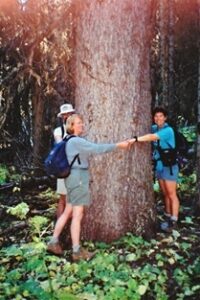
3. Stride into Stability
As you stride along a trail, your leg and core muscles constantly engage, contracting to provide stability and helping you to balance yourself as you negotiate uneven terrain. As these core stabilizing muscles strengthen over time, your sense of balance improves. As you hike, informed by the nerve endings in the fascia of your feet and legs, your brain processes every log, rock, root, patch of mud, and puddle. It gauges what it will take to step over or around such obstacles. With practice, one’s brain becomes more adroit at assessing and responding to these barriers, and as a result, balance gets better. Thus, hiking helps boost proprioception, the mind’s awareness of the position and movement of the body in relation to its surroundings.
Strategic use of trekking poles can further improve one’s poise especially while crossing creeks or descending steep terrain. As one gets into middle-age, using them can also save wear and tear on knee, hip, and ankle joints, enabling one to hike well into one’s 60s, 70s, and beyond. Maintaining a good sense of balance is one of the most important skills needed as one grows older since falls account for the majority of reasons why elders enter long term care facilities.
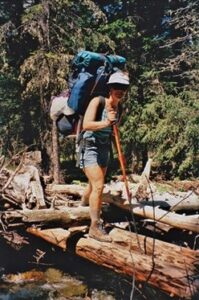
4. March for Your Muscles
Besides building up the stabilizing muscles in the legs and core to enhance your balance, hiking also strengthens the other muscles of the body including the arms and back. Hiking exercises nearly every major muscle group in the body. Walking uphill engages big muscles on the front (quadriceps) and back of your legs (glutes, hamstrings, and calves) while hiking downhill engages the fine muscles around your ankles, the sides of your hips, and your inner core. If you use trekking poles and carry a moderate to heavy backpack, you will significantly strengthen your arm and back muscles. Long-distance hiking really is a full body workout! As such, to avoid strain and injury, one should physically train for a major backpacking trip with shorter trips, gradually building up your strength to carry weight and keeping your pack weight reasonable.
5. Hike Up to Build Up Your Bones
High impact, weight-bearing activities like hiking up a steep trail while carrying a pack on your back helps to improve bone density (the amount of bone mineral in your bones) by strengthening your actual bone tissue. By strengthening your bones they will be less likely to break under moderate stress and you reduce your risk for osteoporosis. The dose of vitamin D from sunlight will also help your bone health.
6. Hike for Healthy Weight
Doctors recommend that adults get at least 150 minutes (2.5 hours) of physical activity every week. However, when hiking the GDT, you will get far more than 2.5 hours of hiking per day. The number of calories burned while hiking depends on many factors, including one’s existing weight, Body Mass Index or BMI[1], gender, plus the aerobic intensity, distance, and duration of the hike, and the fuel (calories from food) that you consume. During multi-day long-distance hikes, people tend to replace excess fat with muscle. This can result in gradual weight loss, but not always. Muscle weighs more than fat, so with some people, they will look slimmer and feel better even though they may weigh a bit more. Skinny individuals lacking in muscle tone may also gain weight, becoming lean and strong.
Maintaining one’s energy levels with enough calories from nourishing food can prove challenging on long-distance trails and requires careful planning. Setting out to use long-distance hiking as a means to lose weight quickly could prove disastrous on wilderness routes like Canada’s GDT, especially during bouts of cold, inclement weather. One must also be wary of getting used to consuming a lot of calorie dense foods while on a long-distance trek. That habit needs to change after you complete the hike, or else the pounds will pile on and that hard-earned muscle will turn back to fat.
Mental & Emotional Benefits of Hiking
1. Hiking to Get Smart
Research reveals that what is good for the circulatory system is also good for the nervous system. When you hike, more blood flows to your brain, carrying with it oxygen and important nutrients. This increased blood flow improves connections between neurons in the parts of the brain that are in charge of memory and cognitive function.
Evidence shows that older adults who exercise regularly have improved memory compared to those that don’t. In a paper published in The Neurology Paper in 2008, older adults who never exercised showed clear signs of cognitive decline. After six months in a walking program, their mental decline reversed appreciably. Another study at the University of California measured the cognitive abilities of 6000 women over 65 years old. They discovered that the women who walked the most had the least mental decline.
Science proves that getting exercise, especially outside in nature, helps individuals focus and improves the ability to process information. Walking keeps your mind sharp and alert, which is a good thing on the GDT, which is prime bear country.
2. Wandering into Wonder and Mental Wellbeing
Many studies support the idea that connecting with nature improves mental health. Whether we are taking in the immensity of a dark sky filled with stars, waking up to the spectacular glow of a sunrise over the Rockies, or gazing out at a field of beautiful alpine wildflowers, these brief moments when we feel a sense of wonder and awe in nature help us feel happy and contented. Appreciating such beauty triggers the brain to relax and experience positive feelings like gratitude.
Given the existential threats in the world today, many people experience stress and suffering. The rates of mental illnesses like depression and anxiety have increased in the past decade. Evidence abounds that spending time in nature can help focus our attention on the present, be it the view we see, the red squirrel we hear chattering away, or the scent of conifer forests. This helps create a sense of conscious calm, providing an antidote to our otherwise hectic bad news bombarded lives. The feelings induced by hiking in nature can help dissolve chronic “rat race” type stress and induce optimism. Dr. Paul Piff, assistant professor of psychology and social behavior at University of California Irvine, asserts that spending time in nature can evoke “a reduced sense of self-importance relative to something larger and more powerful”. In particular, inhaling the phytoncides found in coniferous forests helps to calm our nervous systems, reducing both psychological and physiological stress.

3. Trek Your Way to Confidence
A 2010 study found that even five minutes of vigorous outdoor exercise a day can help people feel more confident. This is because when one challenges oneself, that sense of accomplishment can lead to improved self-esteem. Travelling the GDT may not always feel great at the time, particularly as you slog up a steep grade while swatting mosquitoes. Yet trekking on a taxing long-distance route can lead to you feeling stronger, more capable, and self-sufficient, with the wherewithal to tackle whatever the world throws at you.
A related benefit of long distance trips on the remote sections of the GDT is to experience and appreciate solitude. Walking one step at a time forces you to slow down, calm your thoughts, and feel immersed in nature.
4. Saunter to Sleep Deeply
Numerous medical studies demonstrate that regular exercise can help improve sleep patterns and relieve insomnia. Moderate exercise increases the amount of slow wave sleep one gets. During this deep sleep, the brain and body rejuvenate. Human growth hormone is released, which supports healthy growth in the young and builds a healthy immune system in fully grown adults. Besides helping us to feel tired and in need of rest, exercise helps to stabilize one’s mood and decompress the busy mind chatter that can lead to negative thinking. This enables the mind and body to relax. Also, being outdoors and receiving natural light affects sleep patterns. As Shawn Stevenson explains in his book, Sleep Smarter, exposure to sunlight, especially in the morning, prompts the production of melatonin (the sleep hormone) at night. Exposure to phytoncides in coniferous forests also appears to induce better deeper sleep.
In some people, vigorous, challenging exercise, particularly late in the day, can rev up one’s system, making it more difficult to fall asleep. Nervous anticipation about a particularly difficult section of trail the next day can also interfere with getting to sleep. This can be exacerbated if one feels cold and/or uncomfortable due to not having the right gear. Being well prepared and setting realistic daily distance goals should ensure you gain the sleep benefits of hiking the GDT.
5. Sound Healing
Parks and other wild areas can offer the opportunity to listen to natural sounds and avoid human-related noise, a rare combination in our increasingly urbanized world. A study published in 2021 in PNAS examined evidence of the health benefits of natural soundscapes in national parks across the United States and quantified the incidence of restorative acoustic environments there. The researchers found 36 publications examining the health benefits of natural sound. Meta-analyses of 18 of them revealed comprehensive evidence for decreased stress and annoyance and improved health and positive affective outcomes. Examples of beneficial results included decreased pain, reduced stress, boosted mood, and enhanced cognitive performance. The results confirmed that natural sounds improve health, increase positive affect[2], and lower stress and annoyance.
Their analyses revealed many national park sites that had a high abundance of natural sound and low human-generated, including mechanical and electronic sounds. Water sounds, such as a gurgling brook or a waterfall, tended to be the most effective at improving positive affect, while bird songs proved best for reducing stress. The study’s lead author, Dr. Rachel Buxton, a research associate and conservation biologist in the Department of Biology at Carleton University in Ottawa, suggests people close their eyes, and be mindful of the sounds they hear when visiting a favorite park. “These sounds are beautiful and good for our health – they deserve our protection,” she added. This research augments the substantial body of evidence that proximity to nature and time spent outdoors improves human health and well-being.
As acoustic ecologist Gordon Hampton, founder of One Square Inch of Silence, says,
“Silence is a part of our human nature, which can no longer be heard by most people. Close your eyes and listen for only a few seconds to the world you live in, and you will hear this lack of true quiet, of silence. Refrigerators, air conditioning systems, and airplanes are a few of the things that have become part of the ambient sound and prevent us from listening to the natural sounds of our environment. It is our birthright to listen, quietly and undisturbed, to the natural environment and take whatever meanings we may from it. By listening to natural silence, we feel connected to the land, to our evolutionary past, and to ourselves.”
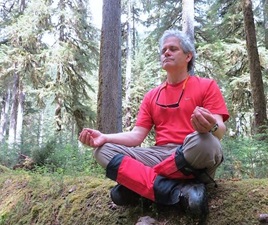
6. Hiking Offers a Chance for a Technology Fast
The average American spends 93% of their time indoors, and some ten hours a day on computers or other electronic screen devices engaging in social media, more time than they spend asleep. People hiking the GDT today rely more on technology than previous generations. The GDT app for iPhones makes finding the GDT route easier, especially in unmarked sections. Devices such as inReach and Spot give us peace of mind in case of emergencies. Our ability nowadays to make and post videos of our GDT trip allows us to widely share our experiences with a huge audience.

However, these technologies bring unintended consequences. Continuing to live our on-trail lives through our iPhones and other devices takes time, time you could be mindfully experiencing nature or resting your mind. Too much focus on technology during a long-distance backpacking trip can lead to stress and anxiety. Keep in mind that software engineers design social media apps to be addictive. Make sure you have periods of time when you experience nature on her terms, without any device mediating what’s happening. Use your hike as an opportunity to disconnect from any addictive dependence on social media and to live in the moment. Don’t scroll when you stroll.
7. Ramblers Rule
Rambling through the Rockies on the GDT helps build a sense of community. If you enjoy hiking long distances over multiple days, chances are you will be traveling in the same direction as other walkers who you will end up getting to know while walking. Long distance walking offers a great way to socialize with these other hiking enthusiasts. Meeting fellow hikers can foster new friendships.
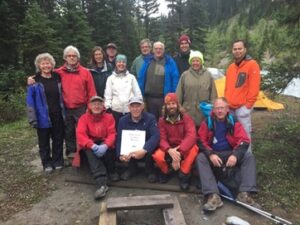
Joining the GDTA and participating in group activities such as trail work trips, educational webinars, and live presentations creates social bonds that can help you feel a part of something worthwhile. If you need more community connections in your life, join the GDTA and consider hiking portions of the GDT. It’s a safe way to meet and befriend other people who enjoy hiking in nature and long-distance trails. They may end up being a friend for life, like Dave and me.
How Can We Give Back?
During the COVID-19 pandemic, numerous people learned about the health benefits of recreating outdoors in nature. While outdoor recreational spaces played an important role in keeping citizens healthy, local parks became overrun with people. Parking, toilet facilities, and trails became strained beyond capacity. Instead of viewing parks and protected areas and long-distance trails as a cost, we as a society, and our government representatives, need to see them as an important investment in the physical and mental wellbeing of Canadians. Trails and parks enable self-care that helps prevent or delay chronic illnesses such as heart disease, diabetes, and dementia. Facilitating long-distance hiking through natural areas should be considered as part of a Canadian health care strategy. All of us who benefit from hiking in nature can give back by supporting and encouraging the protection of natural areas and establishment and maintenance of trails for non-motorized users.
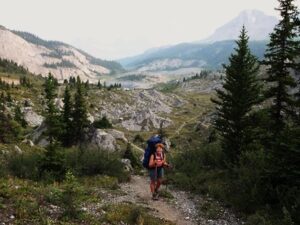
[1] Body mass index (BMI) is a value derived from the mass (weight) and height of a person. The BMI is defined as the body mass (in kilograms) divided by the square of the body height (in metres). Body mass includes all body tissues – muscle, fat, bone, fascia, skin, organs, etc. It is expressed in units of kg/m2. Tables or charts that show BMI as a function of mass and height using contour lines or colours for different BMI categories are usually used to determine an individual’s BMI. The BMI can be used as a means to classify someone as underweight (under 18.5 kg/m2), normal weight (18.5 to 24.9), overweight (25 to 29.9), and obese (30 or more).
[2] Positive affect is the psychological term for a more positive outlook or disposition and the experience of joy and interest.


